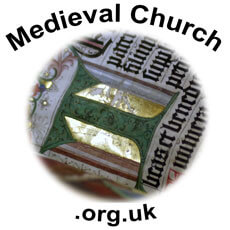Theology on the Web helps over 2.5 million people every year to find high quality theological resources that will help to equip them to serve God and to know Him better (2 Timothy 2:15). Like other websites that provide free services, it is dependent on donations to enable it to grow and develop and only 0.004% of visitors currently do so. If you would like to support this site, please use one of the options to the right of this message.
Synopsis
The second crusade (1147) was caused by the conquest of
Edessa by the Mohammedans,1 and their advance
against Jerusalem. The religious enthusiasm of the West was rekindled. Eugene
III. placed himself at the head of the movement; and Bernard of Clairveaux preached the crusade in France
and Germany, promising certain victory, promising even that God would smite the
hosts of the infidels by a miraculous interference. Two brilliant armies, led
by Conrad III. of Germany and Lewis VII. of France, moved toward the East. But
the Byzantine emperor was more afraid of the crusaders than of the Turks. He
made peace secretly with them; and chiefly by his treachery the German army was
wasted in the defiles of Asia Minor. The French army also suffered severely;
and, when the remnants of the magnificent army joined King Baldwin III. before
the walls of Damascus, famine, disease, dissensions, and the treachery of the
Pallanes (the Christian inhabitants of the besieged city, descendants of the
first crusaders), soon brought the whole undertaking to a sorry end.
Consternation, anger, and de-spair filled the whole of Germany and France; and Bernard added what he could to the misery. He saved
his fame as an inspired prophet by declaring the crusading armies unworthy of
victory, and the defeat a divine punishment of their sins.
1 An
inaccurate, offensive and obsolete name for Muslims. It should not be used by
modern writers.
Philip Schaff, ed., A Religious
Encyclopaedia or Dictionary of Biblical, Historical, Doctrinal, and Practical
Theology, 3rd edn, Vol. 1. Toronto, New York & London: Funk &
Wagnalls Company, 1894. p.577.
Secondary Sources
 |
 Michael Gervers, ed., The
Second Crusade and the Cistercians. New York: Palgrave, 1992. Hbk. ISBN:
0312056079. pp.272. Michael Gervers, ed., The
Second Crusade and the Cistercians. New York: Palgrave, 1992. Hbk. ISBN:
0312056079. pp.272. |
 |
 Thomas F. Madden, A Concise
History of the Crusades. Rowman and Littlefield Publishers Inc., 2000. Hbk.
ISBN: 0847694291. pp.39-63. Thomas F. Madden, A Concise
History of the Crusades. Rowman and Littlefield Publishers Inc., 2000. Hbk.
ISBN: 0847694291. pp.39-63. |
 |
 Jonathan Phillips & Martin Hoch, eds. The Second
Crusade. Manchester: Manchester University Press, 2001. Pbk. ISBN:
0719057116. pp.256. Jonathan Phillips & Martin Hoch, eds. The Second
Crusade. Manchester: Manchester University Press, 2001. Pbk. ISBN:
0719057116. pp.256. |
Related Subjects
 Michael Gervers, ed., The
Second Crusade and the Cistercians. New York: Palgrave, 1992. Hbk. ISBN:
0312056079. pp.272.
Michael Gervers, ed., The
Second Crusade and the Cistercians. New York: Palgrave, 1992. Hbk. ISBN:
0312056079. pp.272.  Thomas F. Madden, A Concise
History of the Crusades. Rowman and Littlefield Publishers Inc., 2000. Hbk.
ISBN: 0847694291. pp.39-63.
Thomas F. Madden, A Concise
History of the Crusades. Rowman and Littlefield Publishers Inc., 2000. Hbk.
ISBN: 0847694291. pp.39-63.  Jonathan Phillips & Martin Hoch, eds. The Second
Crusade. Manchester: Manchester University Press, 2001. Pbk. ISBN:
0719057116. pp.256.
Jonathan Phillips & Martin Hoch, eds. The Second
Crusade. Manchester: Manchester University Press, 2001. Pbk. ISBN:
0719057116. pp.256. 










